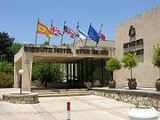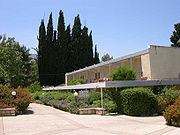
Kfar Giladi
Encyclopedia


Kibbutz
A kibbutz is a collective community in Israel that was traditionally based on agriculture. Today, farming has been partly supplanted by other economic branches, including industrial plants and high-tech enterprises. Kibbutzim began as utopian communities, a combination of socialism and Zionism...
in the finger of the Galilee
Finger of the Galilee
The Finger of the Galilee is a panhandle along the Hula Valley in northern Israel. It contains the towns Metula and Kiryat Shmona and the rivers of Dan and Banias...
panhandle of northern Israel
Israel
The State of Israel is a parliamentary republic located in the Middle East, along the eastern shore of the Mediterranean Sea...
. Located south of Metula
Metula
Metula is a town in the Northern District of Israel. Metula is located between the sites of the Biblical cities of Dan, Abel Bet Maacah, and Ijon, bordering Lebanon.-Early history:...
on the Naftali Mountains above the Hula Valley and along the Lebanese border
Blue Line (Lebanon)
The Blue Line is a border demarcation between Lebanon and Israel published by the United Nations on 7 June 2000 for the purposes of determining whether Israel had fully withdrawn from Lebanon...
, it falls under the jurisdiction of Upper Galilee Regional Council
Upper Galilee Regional Council
The Upper Galilee Regional Council is a regional council in Israel's Upper Galilee region.The area has a population of 15,500 and has been headed for 14 years by Aharon Valenci. Its headquarters are located in Kiryat Shmona, an independent city not included in the council's jurisdiction.-Regional...
.
History
The kibbutz was founded in 1916 by members of HashomerHashomer
Hashomer was a Jewish defense organization in Palestine founded out of Bar-Giora in April 1909. It ceased to operate after the founding of the Haganah in 1920. The purpose of Hashomer was to provide guard services for Jewish settlements in the Yishuv, freeing Jewish communities from dependence...
on land owned by the Jewish Colonization Association
Jewish Colonization Association
The Jewish Colonization Association was created on September 11, 1891 by the Baron Maurice de Hirsch. Its aim was to facilitate the mass emigration of Jews from Russia and other Eastern European countries, by settling them in agricultural colonies on lands purchased by the committee, particularly...
, and was named after Israel Giladi, one of the founders of the Hashomer movement. The area was subject to intermittent border adjustments between the British and the French, and in 1919, the British relinquished the northern section of the Upper Galilee containing Tel Hai
Tel Hai
Tel Hai is the modern name of a settlement in northern Israel, the site of an early battle in the Arab–Israeli conflict, and of a noted monument, tourist attraction, and a college...
, Metula
Metula
Metula is a town in the Northern District of Israel. Metula is located between the sites of the Biblical cities of Dan, Abel Bet Maacah, and Ijon, bordering Lebanon.-Early history:...
, Hamra
Hamra, Bik'at HaYarden
Hamra is a moshav and Israeli settlement in the West Bank. Located in the Jordan Valley and covering 3,500 dunams, it falls under the jurisdiction of Bik'at HaYarden Regional Council...
, and Kfar Giladi to the French
France
The French Republic , The French Republic , The French Republic , (commonly known as France , is a unitary semi-presidential republic in Western Europe with several overseas territories and islands located on other continents and in the Indian, Pacific, and Atlantic oceans. Metropolitan France...
jurisdiction. After the Arab attack on Tel Hai in 1920, it was temporarily abandoned. Ten months later, the settlers returned. Tel Hai was absorbed into Kfar Giladi in 1926.
On August 6, 2006, during the 2006 Israel-Lebanon conflict
2006 Israel-Lebanon conflict
The 2006 Lebanon War, also called the 2006 Israel-Hezbollah War and known in Lebanon as the July War #Other uses|Tammūz]]) and in Israel as the Second Lebanon War , was a 34-day military conflict in Lebanon, northern Israel and the Israeli-occupied territories. The principal parties were Hezbollah...
, twelve reserve IDF
Israel Defense Forces
The Israel Defense Forces , commonly known in Israel by the Hebrew acronym Tzahal , are the military forces of the State of Israel. They consist of the ground forces, air force and navy. It is the sole military wing of the Israeli security forces, and has no civilian jurisdiction within Israel...
soldiers were killed after being hit by a Katyusha rocket launched by Hezbollah from Southern Lebanon
Southern Lebanon
Southern Lebanon is the geographical area of Lebanon comprising the South Governorate and the Nabatiye Governorate. These two entities were divided from the same province in the early 1990s...
. The group of artillery gunners were gathering on the kibbutz in preparation for action in the conflict.
Economy
Kfar Giladi is home to several diverse industries, including agriculture, a quarry, nurseries, an eyewear factory (Galilee Optics, which closed in 2005) and a modern hotel.The agricultural activities of the kibbutz include the growing of apples and avocados, the main crops that are considered a significant portion of the kibbutz's income. Volunteers are solicited to help pick the fruits during the harvest season along with kibbutz members.
Other crops include lychee
Lychee
The lychee is the sole member of the genus Litchi in the soapberry family, Sapindaceae. It is a tropical and subtropical fruit tree native to Southern China and Southeast Asia, and now cultivated in many parts of the world...
s, corn
Maize
Maize known in many English-speaking countries as corn or mielie/mealie, is a grain domesticated by indigenous peoples in Mesoamerica in prehistoric times. The leafy stalk produces ears which contain seeds called kernels. Though technically a grain, maize kernels are used in cooking as a vegetable...
, cotton
Cotton
Cotton is a soft, fluffy staple fiber that grows in a boll, or protective capsule, around the seeds of cotton plants of the genus Gossypium. The fiber is almost pure cellulose. The botanical purpose of cotton fiber is to aid in seed dispersal....
, wheat
Wheat
Wheat is a cereal grain, originally from the Levant region of the Near East, but now cultivated worldwide. In 2007 world production of wheat was 607 million tons, making it the third most-produced cereal after maize and rice...
, and potato
Potato
The potato is a starchy, tuberous crop from the perennial Solanum tuberosum of the Solanaceae family . The word potato may refer to the plant itself as well as the edible tuber. In the region of the Andes, there are some other closely related cultivated potato species...
es. Livestock includes chickens and dairy cows, and fish ponds.
Several older buildings stand on the kibbutz that memorialize previous battles on the site, before and during the 1948 Arab-Israeli War
1948 Arab-Israeli War
The 1948 Arab–Israeli War, known to Israelis as the War of Independence or War of Liberation The war commenced after the termination of the British Mandate for Palestine and the creation of an independent Israel at midnight on 14 May 1948 when, following a period of civil war, Arab armies invaded...
.
The kibbutz's hotel is a modern facility with several three-story structures located close to a communal dining room and indoor and outdoor pools. Cafeteria and hotel workers include lifelong kibbutz residents and students from the nearby Tel Hai Academic College, Israel's northernmost institution of higher education. Some college staffers come up for a day or two a week from Tel Aviv
Tel Aviv
Tel Aviv , officially Tel Aviv-Yafo , is the second most populous city in Israel, with a population of 404,400 on a land area of . The city is located on the Israeli Mediterranean coastline in west-central Israel. It is the largest and most populous city in the metropolitan area of Gush Dan, with...
and other points south and use the hotel for regular weekly lodging.
Archaeology
An archaeological site at Kfar Giladi was excavated by J. Kaplan in 1957 and 1962. It revealed remains four stages of occupation in different periods. An early neolithicNeolithic
The Neolithic Age, Era, or Period, or New Stone Age, was a period in the development of human technology, beginning about 9500 BC in some parts of the Middle East, and later in other parts of the world. It is traditionally considered as the last part of the Stone Age...
stage was suggested to date between 6400 and 5800 BC. Finds included Dark faced burnished ware
Dark faced burnished ware
Dark Faced Burnished Ware or DFBW is the earliest form of pottery developed in the western world.It was produced after the earliest examples from the indepenent phenomenon of the Jomon culture in Japan and is predominantly found at archaeological sites in Lebanon, Israel and southwest Syria...
with incisions and rope
Rope
A rope is a length of fibres, twisted or braided together to improve strength for pulling and connecting. It has tensile strength but is too flexible to provide compressive strength...
patterns. Flint
Flint
Flint is a hard, sedimentary cryptocrystalline form of the mineral quartz, categorized as a variety of chert. It occurs chiefly as nodules and masses in sedimentary rocks, such as chalks and limestones. Inside the nodule, flint is usually dark grey, black, green, white, or brown in colour, and...
s included axe
Axe
The axe, or ax, is an implement that has been used for millennia to shape, split and cut wood; to harvest timber; as a weapon; and as a ceremonial or heraldic symbol...
s, adze
Adze
An adze is a tool used for smoothing or carving rough-cut wood in hand woodworking. Generally, the user stands astride a board or log and swings the adze downwards towards his feet, chipping off pieces of wood, moving backwards as they go and leaving a relatively smooth surface behind...
s, arrowhead
Arrowhead
An arrowhead is a tip, usually sharpened, added to an arrow to make it more deadly or to fulfill some special purpose. Historically arrowheads were made of stone and of organic materials; as human civilization progressed other materials were used...
s and denticulated sickle
Sickle
A sickle is a hand-held agricultural tool with a variously curved blade typically used for harvesting grain crops or cutting succulent forage chiefly for feeding livestock . Sickles have also been used as weapons, either in their original form or in various derivations.The diversity of sickles that...
blade elements. Similar finds were located in a later neolithic stage including a female clay
Clay
Clay is a general term including many combinations of one or more clay minerals with traces of metal oxides and organic matter. Geologic clay deposits are mostly composed of phyllosilicate minerals containing variable amounts of water trapped in the mineral structure.- Formation :Clay minerals...
figurine dating between 5800 and 5400 BC. Two later periods of occupation were attributed to chalcolithic occupations similar to Wadi Rabah.
Another nearby neolithic site was excavated by M. Lechevallier & G. Dollfus in 1973. They found Byblos points and tips of Jericho points and Amuq points, polished cutting axes, chisels and fine-toothed sickles. Finds were similar to Tell Ramad
Tell Ramad
Tell Ramad is a prehistoric, Neolithic tell at the foot of Mount Hermon, about southwest of Damascus in Syria. The tell was the site of a small village of , which was first settled in the late eighth millennium....
.

